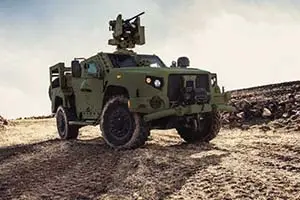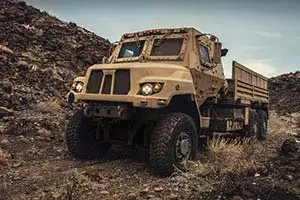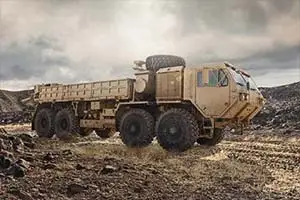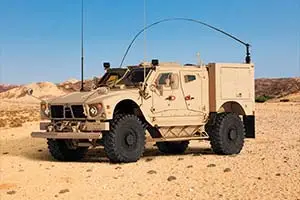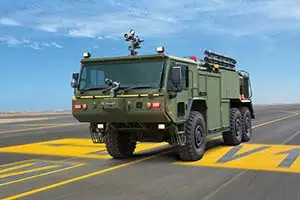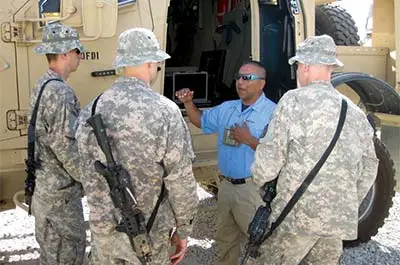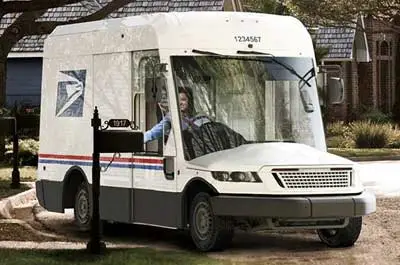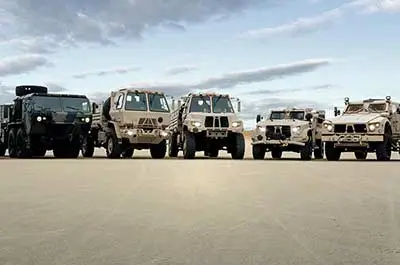OSHKOSH, Wis. — Feb. 10, 2009 — Effective and sustainable off-road vehicle mobility is critical to the urgent-need requirements set by the U.S. Department of Defense (DoD) in its recent call for MRAP All Terrain Vehicle (M-ATV) proposals. Oshkosh Defense, a division of Oshkosh Corporation (NYSE:OSK), offers its M-ATV vehicle designed around the company’s successful Medium Tactical Vehicle Replacement (MTVR) chassis and TAK-4® independent suspension system. Oshkosh offers a mature, battle-tested chassis and suspension system, resulting in a mission-ready vehicle that provides exceptional mobility in Afghanistan’s most rugged and remote terrain.
The Oshkosh® patented TAK-4 independent suspension is the only off-road, battle-tested independent suspension system currently used by U.S. forces for this vehicle class and is being considered by the DoD as a significant suspension upgrade for the MRAP fleet currently in service in Iraq. In addition to providing superior off-road mobility, the TAK 4 independent suspension provides better maneuverability, and improved ride quality than straight axle vehicles. The vehicle’s suspension system combined with a powerful drivetrain, allows the Oshkosh M-ATV to carry heavier armor as threats evolve.
“The Oshkosh M-ATV is the most qualified vehicle to meet the DoD’s requirements regarding mobility because of its proven TAK-4 independent suspension system on the MTVR chassis, which has already been used in Afghanistan’s mountainous battlefields,” said John Stoddart, Oshkosh Corporation executive vice president and president, Defense. “Our main focus is to deliver the best vehicle system solution that provides the survivability and mobility to get U.S. forces into and out of the fight in places where other vehicles fear to tread.”
MTVRs are conducting missions in Afghanistan with many Oshkosh vehicles exceeding 70,000 operational miles and with readiness rates greater than 92 percent. In addition, the M-ATV independent suspension components are readily available because both the MTVR and Logistics Vehicle System Replacement (LVSR) use the TAK-4 system and are currently in production.
The Oshkosh M-ATV matches the MTVR’s capacity for 70-percent off-road mobility and provides more than 16 inches of independent wheel travel, which exceeds the government’s M-ATV requirements, to deliver the best off-road mobility in Afghanistan. Oshkosh delivers the M-ATV with the survivability, mobility and mission-proven solutions required for Afghanistan. The contract award for the new M-ATV has a potential value of $2 billion.
About Oshkosh Defense
Oshkosh Defense, a division of Oshkosh Corporation, is an industry-leading global designer and manufacturer of tactical military trucks and armored wheeled vehicles, delivering a full product line of conventional and hybrid vehicles, advanced armor options, proprietary suspensions and vehicles with payloads that can exceed 70 tons. Oshkosh Defense provides a global service and supply network including full life-cycle support and remanufacturing, and its vehicles are recognized the world over for superior performance, reliability and protection. For more information, visit oshkoshdefense.com.
About Oshkosh Corporation
Oshkosh Corporation is a leading designer, manufacturer and marketer of a broad range of specialty access equipment, commercial, fire & emergency and military vehicles and vehicle bodies. Oshkosh Corp. manufactures, distributes and services products under the brands of Oshkosh®, JLG®, Pierce®, McNeilus®, Medtec®, Jerr-Dan®, BAI®, Oshkosh Specialty Vehicles, Frontline™, SMIT™, Geesink™, Norba™, Kiggen™, CON-E-CO®, London® and IMT®. Oshkosh products are valued worldwide in businesses where high quality, superior performance, rugged reliability and long-term value are paramount. For more information, log on to www.oshkoshcorporation.com.
• TAK-4 is a registered trademark of Oshkosh Corporation.
Forward-Looking Statements
This press release contains statements that the Company believes to be “forward-looking statements” within the meaning of the Private Securities Litigation Reform Act of 1995. All statements other than statements of historical fact, including without limitation, statements regarding the Company’s future financial position, business strategy, targets, projected sales, costs, earnings, capital expenditures, debt levels and cash flows, and plans and objectives of management for future operations, are forward-looking statements. When used in this press release, words such as “may,” “will,” “expect,” “intend,” “estimate,” “anticipate,” “believe,” “should,” “project” or “plan” or the negative thereof or variations thereon or similar terminology are generally intended to identify forward-looking statements. These forward-looking statements are not guarantees of future performance and are subject to risks, uncertainties, assumptions and other factors, some of which are beyond the Company’s control, which could cause actual results to differ materially from those expressed or implied by such forward-looking statements. These factors include the consequences of financial leverage associated with the JLG acquisition, especially given turmoil in the credit markets, the level of the Company’s borrowing costs and the Company’s ability to successfully amend its credit agreement to provide financial covenant relief; the cyclical nature of the Company’s access equipment, commercial and fire & emergency markets, especially during a global recession and credit crisis; the Company’s ability to obtain cost reductions on steel and other raw materials following sharp cost increases in 2008, obtain other cost decreases or achieve product selling price increases; the duration of the global recession and its adverse impact on the Company’s share price, which could lead to impairment charges related to many of the Company’s intangible assets; the expected level and timing of U.S. Department of Defense procurement of products and services and funding thereof; risks related to reductions in government expenditures and the uncertainty of government contracts; risks associated with international operations and sales, including foreign currency fluctuations; the Company’s ability to turn around its Geesink business; risks related to the collectibility of receivables during a recession, especially access equipment receivables; and the potential for increased costs relating to compliance with changes in laws and regulations. Additional information concerning these and other factors is contained in the Company’s filings with the Securities and Exchange Commission.
